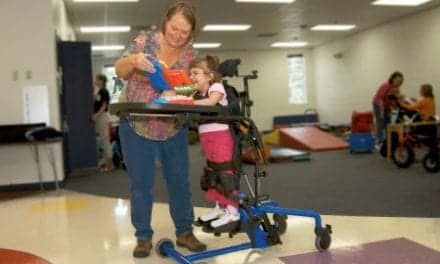Strategic thinking for developing pediatric mobility solutions that grow with their users
by Frank Long, MS, Editorial Director
Children begin as simple creatures whose needs are distributed mostly around the base of Maslow’s pyramid. As they begin to pass major developmental milestones, however, that simplicity gives way to social, emotional, and movement needs that become more complex. For children who use mobility devices, their needs will become even more complex by the length of duration of wheelchair use, need for social participation, and transitional care into adulthood.1 To ensure a healthy path toward forward for these individuals, therapists must understand how to plan for their growth and create mobility solutions that accommodate the body’s changes.
It Takes a Team
Managing the mobility needs of a pediatric client from childhood to adolescence requires a wide scope of knowledge. Interdisciplinary healthcare teams are assembled to provide that knowledge by bringing expertise from a variety of allied healthcare professions that ensures each client’s mobility needs are met with the best information available. Kennedy Krieger Institute, Baltimore, leverages the interdisciplinary concept to provide mobility solutions to the pediatric population it serves. Erin Michael, PT, DPT, ATP/SMS, Manager of Patient Advocacy and Special Programs at Kennedy Krieger Institute’s International Center for Spinal Cord Injury (ICSCI) and coordinator of the ICSCI Seating and Mobility Clinic, explains that the center’s interdisciplinary culture provides a special set of advantages that positively affect health and quality of life.
“We involve multiple specialties in the care of our pediatric mobility users, but family members and community providers are also part of the team,” Michael says.
The members of this interdisciplinary team, Michael notes, can provide critical input into all aspects of a child’s needs.
“We gain much better insight into how a child functions, such as where they need to be able to go and what their limitations are. We also learn what their strengths are,” she adds.
Michael, who is also coordinator of the ICSCI Seating and Mobility Clinic, explains that the center provides care for a wide variety of diagnoses. Among them are spinal cord injury (traumatic, non-traumatic, spina bifida), brain injury, cerebral palsy, muscular dystrophy, and autism. Interdisciplinary care is also provided for diagnoses such as delayed milestone, intellectual disability, Rett’s syndrome, acute flaccid myelitis, transverse myelitis, and rare genetic pediatric disorders.
Growing with Manual and Power Mobility
Meeting the needs of such a wide range of diagnoses requires an equally expansive range of wheelchair options, including manual and power technologies. Manual wheelchairs are prevalent among pediatric mobility users and the most widely used assistive mobility device for children younger than age 18 years.2 With such vast numbers of manual wheelchairs in use, it is critical that therapists design them to function safely throughout several years of growth.
Meredith Linden, PT, DPT, ATP/SMS, clinical specialist at ICSCI, explains that one way to extend the life of a folding manual wheelchair and keep it lightweight is to make the chair wider by replacing the cross-brace. She emphasizes that this occurs as a direct replacement and only when needed.
“The frame can be the width necessary at the time of wheelchair delivery, preventing added weight and ensuring more optimal upper extremity position and mechanics for propulsion,” Linden says. For rigid and folding frame wheelchairs, Linden continues, a therapist can add a small bit of length on the frame while setting the backrest and cushion in the appropriate position for the patient’s size at time of delivery.
“An inch or two of frame depth does not add significant weight and the seating still accommodates the user’s existing size,” Linden says. “Our experience is that younger children primarily grow in length, rather than in width, so this is our priority when it comes to accounting for growth.”
Linden and Michael point out that pediatric wheelchairs oftentimes are “adult” chairs that have been shrunken. This creates a complex issue when it comes to mounting components and rear wheel position, since the wheels end up too far posterior. This negatively impacts propulsion efficiency and upper extremity health over time. The two therapists observe that one manufacturer’s pediatric wheelchair design has altered component mounting and growth to place the focus on ensuring optimal rear wheel position.
A Material Issue
What criteria should therapists use to determine whether the frame material will best meet a user’s needs? Michael says that at ICSCI clinicians consider overall weight, maintenance, insurance coverage, and cost—especially if a wheelchair user’s family must pay out-of-pocket for any upcharges.
According to Michael, one manufacturer has combined an aluminum frame with a carbon fiber, growth-ready seat pan to reduce weight. The carbon shell, she says, allows for growth in width and depth. “This hybrid concept is newer to wheelchair frames but has historically been used in cushions to combine strengths of different materials to maximize the function of the equipment,” Michael says.
For pediatric users the weight of the wheelchair can be very similar to, or even greater than, the user’s body weight. Michael explains that research shows overall chair weight and the number of years using a wheelchair are key factors in declining upper extremity health for the manual wheelchair user. This, she says, puts pediatric manual wheelchair users at very high risk for upper extremity pain and dysfunction over their lifetime.
Power Play
For children who are affected by a mobility impairment few technologies carry the “big picture” implications of wheelchairs, that enable users to complete personal care tasks and are virtually indispensable in promoting social inclusion. Power wheelchairs can provide a number of features that help facilitate user growth and independence, so therapists should know how to properly match them to the user. That matching process may begin on the low-tech end of the spectrum by modifying off-the-shelf ride on toys with switches for driving. Linden says this may benefit pediatric patients who are younger than age 36 months. The modified toys can provide mobility to very small children, either prior to their ability to fit into a wheelchair seating system or by providing a lower-cost, easier-to-transport mobility option.
“This also allows a child to play with their peers using same or similar power toys,” Underscoring the value of play, Linden notes that one power wheelchair manufacturer has created a mobile weight-bearing device using a similar concept, by modifying it with a midline joystick.
Power Function Ups and Downs
According to Linden, most power wheelchair manufacturers offer power seat height adjustability as an option on their wheelchairs. This feature, she explains, allows the child access to their environment at different heights, improving their functional reach and participation. It allows for easier transfers by allowing them to be level with or higher than the surface to which they are transferring and improves their safety by allowing them to be visible in crowds, she adds.
Age-appropriate play and development are vital to the pediatric population, and ability to access the ground for these purposes is a function for which power mobility can lend a hand. Linden and Michael point out that a power mobility base that provides power seat height adjustability to the floor is currently available on the market. The feature is particularly important to their patients who have reportedly utilized the device in school for “circle time,” or to access the floor for crawling, prone time, or other mobility.
Device weight is not a significant factor in power wheelchair selection. Thus, power chairs have growth built into them and allow for therapists to consider a range of sizes when pulling together an optimal solution for the pediatric client. A chair can be set to the child’s existing size at delivery and grown, as necessary, according to Michael.
Drive to Succeed
Cognitive ability, motor impairment, and judgement skills all may fluctuate as pediatric wheelchair users grow, but they are crucial variables in the calculus that determines the best control mechanism for a power wheelchair. The effect these technologies have on adjusting to changes in these variables makes them particularly important. Linden and Michael say that when there are substantial changes in a pediatric client the therapist may use programming modifications to maximize the client’s independence and safety.
One example of this type of modification is the elimination of specific directional commands during training. This, Michael says, allows development of cause and effect, while reducing frustration and maximizing safety.
“Programming modifications can also be made to limit the response of the chair to extraneous movements, again reducing frustrations and allowing a child to gradually develop driving skill,” Michael adds.
Linden says that modifying drive control methods for complex power wheelchairs as a way to progress with the user’s needs can be relatively easy—including shifting between joysticks, head array, switches, and other types of technologies. Inability to use a joystick, Linden adds, should not rule out power mobility, and she advises regular follow-up to ensure maintenance of the proper fit and function of the equipment and maximal independence.
Both therapists agree that throughout the wheelchair provision process, cognitive function, posture, and grasp of the concept of cause and effect are regularly assessed. This concept, they explain, is foundational to understanding how to start and stop the chair and maintain safety for all involved. Likewise, it is important to provide optimal postural support to the child to promote their success using the access method.
Recognizing the strong correlation between development and ability to move oneself, too, is deeply important, say Linden and Michael. Mobility, they note, promotes gains in cognition, spatial awareness and perception, vision, and language. Thus, a lack of these skills is not meant to rule out power mobility.
Reflecting on the years they have spent working with the pediatric population, Linden and Michael point back at an important truth that most stakeholders in the pediatric mobility process should recognize: Self-initiated movement facilitates motivation, and motivation facilitates independence. RM
Frank Long, MS, is Editorial Director of Rehab Management. For more information, contact [email protected].
References
- Slavens BA, Schnorenberg AJ, Aurit CM, et al. Evaluation of pediatric manual wheelchair mobility using advanced biomechanical methods. Biomed Res Int. 2015;2015:634768. doi: 10.1155/2015/634768.
- Kaye H, Kang T, LaPlante M. Mobility device use in the United States. Disability Statistics Report. 2000.





